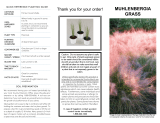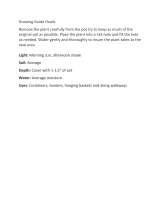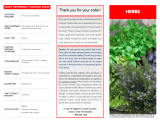Page is loading ...

*Image on cover is representative of the type of plant(s) in this offer and
not necessarily indicative of actual size or color for the included variety
.
DELOSPERMA
Thank you for your order!
PLANT WARRANTY
We warrant perennials for 1 year and
annuals for 90 days from the time of the
original shipment. If for any reason you
are dissatisfied, we will replace your plant
with a similar or comparable one, at no
charge. If your replacement is not available
or it is too late in the season to ship, it will
reship the following shipping season.
If you have any questions or concerns
about your order, please contact us at 888-
593-3644 or [email protected].
Caution: Do not assume any plant is safe to
eat. Only parts of plants expressly grown to
be eaten should be considered edible. As
with any product that is not food, care
should be taken to make sure that small
children and pets do not ingest any part of
the plant that is not expressly grown to be
eaten.
Unless specifically stated, this product is
intended for ornamental horticultural use
only and is not intended for consumption
or ingestion by humans or pets. Most
plants are harmless, but some contain toxic
substances which can cause adverse health
effects. Furthermore, some individuals and
some animals are sensitive or allergic to
certain plants and precautions should be
taken to limit or avoid physical contact with
particular plants. Some plants have thorns
or spines that can be painful if handled.
In case of ingestion contact a poison
control center immediately.
1-800-222-1222
SOI L PREPA RAT ION
Full sun.
LIGHT/SUN
EXPOSURE
USDA HARDINESS
ZONES
PLANTING
DISTANCE
IN-GROUND
MATURE
HEIGHT / SPREAD
1 to 4 inches tall with a 12 to 24
inch spread.
Late spring to fall.
24 months.
Commonly known as ice plants.
Drought tolerant.
Great for rock gardens and containers.
BLOOM TIME
TIME TO REACH
MATURITY
FACTS OF NOTE
PLANT TYPE
Perennial.
CONTAINER SIZE
One plant per 12 inch or larger
container.
We recommend having your soil tested periodically by
your local County Extension Office (www.nifa.usda.gov/
extension or by calling 1-800-333-4636). A soil test can
determine if your soil needs any amendments to enhance
the growth and performance of your plants.
Ideal garden soil is easy to dig in and drains well while still
holding the nutrients and water vital to plant growth. To
prepare a bed for in-ground planting, spade or till the soil
to a depth of roughly 12-18 inches. Next, spread a 2-4 inch
layer of organic matter such as compost, shredded leaves
or peat moss over the soil and mix well.
QUI CK R EFERENCE PLANTING GUIDE
5 to 9.
At least 12 inches apart.

PLANTING INSTRUCTIONS ( Con tinued )
PLANTING I NSTRUCTIONS
FEEDING
Occasionally feed your plants during the growing
season with a water-soluble fertilizer. Discontinue
feeding after September 1st so your plants can
harden off for winter. Resume fertilizing when new
growth appears in the spring.
MULCHING
Keep the area around your plants free of weeds.
Weeds compete with surrounding plants for food,
water and light. Walk around the garden periodically
and pull weeds, including the roots, as soon as you
see them.
WINTERIZING
Delosperma is very hardy and does not require any
special winter protection when planted in-ground.
In very cold areas, containerized plants can be
brought into an unheated, protected area such as a
garage or cellar before temperatures drop below
freezing. Check soil moisture every 2-3 weeks and
water as needed during winter.
In spring, containerized plants should be moved
back out into the garden sunlight where they will
begin to repeat their yearly garden performance.
CONTINUING CARE (Continued)
3. Prepare the root ball for planting by gently disturbing
the surface roots with your fingers, fork, or gardening tool
and pruning any damaged roots. This will encourage the
roots to begin growing outward into the new soil.
4. Dig a hole twice as deep and twice as wide as the plant's
root ball. Partially backfill the hole with soil and place the
plant into the hole. The top of the root ball should be level
with the ground surrounding the hole. Refill the hole with
soil, firming the soil around the plant with your fingers.
Check to be sure the plant is not planted too deeply. If it is,
raise the plant carefully and re-firm the soil.
5. Water thoroughly.
Always plant delosperma in well-drained soil or in
containers with drainage holes.
Important:
Thoroughly hydrate the plant by submersing
the root zone in a container of water for 10 minutes while
you prepare for planting.
1. Remove and discard the clear plastic bag from around
the pot.
2. After watering, remove the pot by holding the plant
upside down in one hand and squeezing the sides of the
pot with the other.
Clip off any dead, damaged or unsightly growth as
needed to maintain an attractive appearance.
Remove spent flowers as blooms fade to promote
continuous flowering.
PRUNING
CONTINUING CARE
WEEDING
Apply a 2-4 inch layer of shredded bark, compost,
leaves, straw or other organic matter around your
plants to promote moisture retention, maintain even
soil temperatures and discourage weed growth.
Replenish the mulch as needed.
Adequate and consistent watering is essential during
your plant's first year in the garden. Once delosperma
is established, it is very drought tolerant and requires
little watering.
Due to variable geographical and environmental
conditions, a specific watering schedule is difficult to
define. However, as a rule of thumb, you should not
allow the soil or the original root ball to completely
dry out. During the first summer, you may need to
water as often as every few days in periods of
drought and extreme summer heat. To determine if
your plant needs water, dig a few inches into the soil
next to the plant. If the soil is dry 2-3 inches below the
surface, it is time to water.
If you plant in a container, allow the top half of soil
to dry out moderately between waterings. Water
thoroughly until the soil is well-saturated and excess
water drains out of the drainage holes at the bottom
of the container. Never allow the plants to sit in a
saucer of water. Pots may be kept in saucers after any
excess water has drained from the pot.
WATERING
Your plants have been shipped to you in pots. We urge
you to remove them from the shipping box and plant
them as soon as possible. Should planting be delayed due
to weather or other unforeseen circumstances, roll the
plastic bag down around each plant and place them near
a bright window or other sunny location. Keep them well-
watered in their pots until permanently planted. Once
planted, they begin setting roots and, as the weather
warms, begin showing new growth. Please plant as soon
as possible, provide reasonable care and be patient.
DELOSPERMA
The foliage on potted plants may appear slightly wilted or
yellow upon arrival. This is due to the stress of shipping
and is usually nothing to worry about. Water the plant
thoroughly, place it in a shady location for a few days and
remove any foliage that does not recover.
OUT OF THE BOX
SHIPPED AS SHOWN
/








